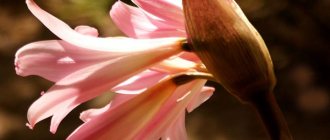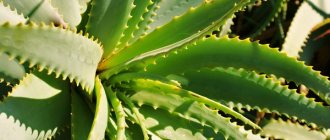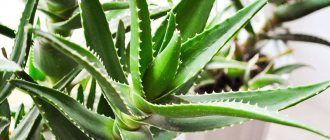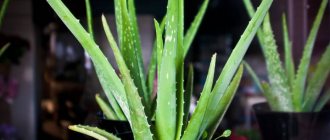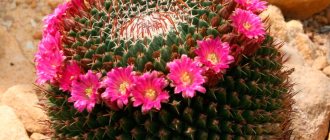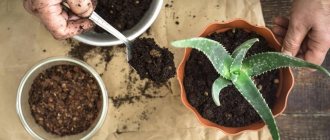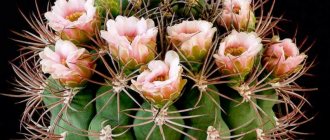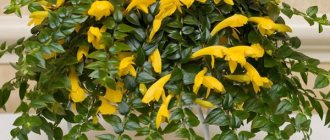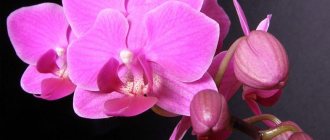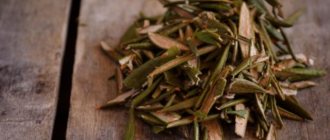Most readers will agree that in a home where family health is a top priority, there is sure to be a place for an indoor aloe vera plant. This pet is extremely popular in Russia since time immemorial. The historical path of the plant as a medicine lasts more than 4 thousand years.
Aloe vera is a flower, the first images of which were distinguished on the walls of the temples of ancient Egypt, venerable 6 thousand years old. This is a great representative of succulents - plants that store water in order to survive during prolonged dry times. In such harsh, hot conditions of the African continent, the hardy and unpretentious aloe vera was born. For this reason, growing a flower at home will not be difficult even for a novice amateur gardener.
However, there are often cases of poor health and even death of a flower, accustomed to a “Spartan” way of life, due to gross violations of the conditions of detention and rules of care. Based on the materials in this article, our acquaintance with the family doctor will take place. Here we will reveal the secrets of successfully growing aloe vera, features of planting and care, describe effective methods of propagating the flower and warn about possible difficulties. The florists' tips will be the highlight of the acquired knowledge about the miracle plant.
In its uncultivated form, growing in the vast expanses of the Arabian Peninsula, the Canary Islands and Madagascar, aloe vera reaches 3 m in girth. In indoor conditions, the height of the flower rarely exceeds 60 cm. The medicinal plant of the lily family has a dense rosette of gray-green fleshy leaves about 45 cm long, completely covered with white dotted spots and edged with denticles. The rosette arrangement of leaves minimizes the evaporation of life-giving moisture in desert conditions with an arid climate, from where many succulents came to our apartments. The root system is poorly developed. In its natural habitat, flowering can be observed every 2-3 years. And only under favorable indoor conditions can a 90-centimeter flower shoot, on the top of which are clusters of yellow tube-shaped flowers, please us with its appearance once every 10 or 20 years in the spring. After flowering, the plant throws out seed pods on the stems. However, the seeds usually do not have time to ripen.
Modern man, having appreciated the unique healing properties of the plant, cultivated it on a grand scale, planting entire plantations and building processing factories. To take advantage of the ability of a medicinal plant to disinfect the air, as well as emergency healing help right at home, flower growers of various ranks acquire aloe vera on their windowsills. This plant is the leader in the top five of all known 500 species of aloe with medicinal power.
Planting/growing
You will bring freshly purchased aloe into your home, most likely, in a cramped pot. The following signs will help determine the need for a transplant:
- the diameter of the above-ground part of the bush was more than twice the diameter of the pot;
- plant growth is inhibited;
- the root system completely occupied the internal volume of the container.
Allow the plant to adapt to its new location for several weeks, and then proceed with replanting. The answer to the question of how to transplant aloe vera into another pot must begin with a description of the planting container and the composition of the soil.
Succulents feel good in low pots - bowls. For overgrown aloe, choose a more spacious but flat container. It is better to give preference to ceramic material, since it releases excess moisture into the atmosphere, preventing it from stagnating in the root area. Before using for its intended purpose, the pot is washed with soap and disinfected, and the ceramic pot is kept for an hour in a superphosphate solution.
A special purchased soil mixture is considered the best for succulents. In the absence of one, you can prepare your own mixture of leaf soil, coarse sand and humus. Expanded clay, walnut shells or crushed red brick are used for drainage. To achieve good drainage quality, the soil surface is also covered with pebbles.
In the spring, aloe vera is transplanted at home from a smaller pot to a larger one, but only if absolutely necessary. Please note that you need to plant at the same depth each time.
At the bottom of the prepared pot, place a generous layer of drainage of at least 3-4 cm, a little soil mixture and transfer the plant along with the roots and earthen lump to a depth of about 4 cm. Fill the voids formed at the walls with soil. Moisten thoroughly and stop watering for 2-3 weeks so that the plant takes root safely.
It must be remembered that heavy aloe vera leaves and a weak root system can cause the flower to fall on its side. Florists advise adding stability to the plant by securing it in the area where the aerial part emerges with two or three stones.
Aloe Vera - description of the species
Aloe Vera means "Aloe True". The Latin word aloe is translated as “bitter”, the Greek άλός is salt (the plant juice tastes like sea water), the Arabic alloeh is a substance with a pronounced bitter taste.
Aloe as a medicine has been accompanying humans for four thousand years. This is confirmed by cuneiform writing on Sumerian tablets dating back to 2100 BC. e. However, images of this plant were also found on the walls of ancient Egyptian temples built 4 thousand years BC.
Everything, including the appearance and biological characteristics of Aloe itself, suggests that the plant first appeared in hot and dry Africa, and then spread to all other continents. In the wild, it is found on the Arabian Peninsula, Madagascar, the Canary Islands, and North Africa.
Aloe Vera forms a bush with a short stem. The roots are poorly developed. The leaves are long (up to 60 cm), fleshy, covered with thorns along the edges. Many people mistakenly call this succulent a cactus because it can also accumulate and store water. Thanks to this ability, Aloe Vera survived severe climate changes on Earth and today still serves people. In extreme situations, the pores on the skin close, and moisture is retained in the leaves for a long time.
There are 500 species of aloe in nature, but only 5 of them are considered medicinal. Aloe Vera occupies a leading position in this top five; it brings maximum benefits to humans. Growing it is a profitable business. Entire plantations are planted, and there are processing plants.
Aloe vera is considered the most valuable for its medicinal properties among more than half a thousand species of aloe.
Today, this is the only plant that treats burns from the strongest light radiation generated by an atomic explosion. Thus, this ancient natural remedy can be called a miracle of modern times.
Growing in the garden
A completely unusual thing for our latitudes would be to plant an indoor aloe vera flower in open ground on a personal plot. As it turned out, the hardy plant also adapted to outdoor conditions. If you choose this method, care will be greatly simplified: the need for periodic replanting and compliance with the watering regime disappears.
To create comfort for aloe in an open space, the future planting site is cleared of weeds, and the hole is filled with soil familiar to succulents with a 40 percent sand content. Before planting, the roots of the plant should be dried in a dark place for three days. Now you can safely place the home healer directly in the prepared soil. To prevent uninvited weed neighbors from settling in the tree trunk again, florists recommend filling the area around the aloe with stones, and at the same time adding elements of desert decor to the garden. Spoiled leaves that have lost their decorative properties are used as a medicinal and cosmetic product for skin and hair, and as a growth stimulant for vegetable and horticultural crops. The leaves, cut with a thin knife, are wrapped in opaque paper and stored in the refrigerator for at least 10 days to complete the fermentation process. Then they squeeze out the juice and use it for good at their own discretion.
Pre-winter preparation consists of insulation with covering material and wrapping with film. In winter, watering is stopped.
Care
Most often, the beginning of a passion for floriculture coincides with the purchase or acceptance of just a couple of pots of succulent plants as a gift. Among them, in every second case there is a place for aloe vera. Houseplants in this group are easy to care for. To grow well, they need conditions similar to those to which they are accustomed in their natural desert and semi-desert habitat. This is an abundance of sunlight, high-quality drainage, fresh air, watering during the growth period, coolness and dry soil during dormancy. For good development and longevity, plants need a full period of winter dormancy and being outdoors in the summer.
Proper care of aloe vera at home involves following certain rules:
- temperature - moderate from spring to autumn, in winter - not lower than 10°C;
- lighting - bright light on a south-facing window sill, some direct sunlight is required;
- watering - abundant as the soil surface dries, in winter - rare;
- air humidity - spraying the leaves is not necessary, fresh air is important;
- propagation by stem and leaf cuttings, pups and seeds.
What to do if the flower does not take root?
If a flower grown from seeds does not show signs of growth, despite watering, you need to carefully examine the plant. Perhaps the plant was attacked by pests. If they are identified, any suitable preparation for spraying indoor plants will help.
But if the problem is not harmful insects, there is a chance that the plant’s roots are rotting. This can be caused by excessive watering, as well as hypothermia. The agave may die if prompt measures are not taken to save it. To prevent the death of aloe, you must:
- Carefully remove it from the pot.
- Afterwards, rinse the root system with warm water.
- If there are signs of rotting, the affected areas must be cut off with a sharp knife, and the sections must be powdered with crushed coal or sulfur.
- After slightly drying the healthy roots after the procedure, the aloe is planted in the pot again. It is only important to replace the soil in the pot.
If the roots could not be saved at all, you can try to propagate the agave with a leaf, tip or cutting (read how to propagate aloe without roots). If you want to get a guaranteed result and grow agave from a seed, you need to use proven methods. In this case, the shoots will be friendly, and the aloe will be a real source of pride for the grower who grew it.
Temperature
Aloe vera, unlike most houseplants, prefers contrasting day and night temperatures. The flower feels comfortable when the temperature on the thermometer in the room is from 18 to 22 degrees, but not higher than 30ºC. During the dormant period in winter, a coolness of 12 to 14 degrees is required, but not lower than 10ºC. The climate of most living spaces is suitable for the plant. If you send it to the balcony in fresh air for the summer, you should protect it from rain and drafts. By the end of autumn, it is necessary to promptly find a room with cool air for hibernation in ideal conditions.
Watering
The answer to the question of how to water aloe vera at home is extremely simple. The same as most indoor plants: moderately, keeping the surface layer of soil slightly moist, not allowing it to dry out. During hibernation, watering is limited as much as possible to once a month or even twice. Florists recommend ensuring that water does not get on the leaves or run off into the rosette. By watering the flower at the root, you will be able to avoid rotting of the green mass.
High air humidity is not required, therefore, there is no need to spray the leaves. In order for the plant to breathe freely, it is important to provide an influx of fresh air by ventilation, or take it out of the room. An effective way is to wipe the leaves from dust and dirt with a damp cotton cloth or sponge.
Top dressing
Before you give aloe care using fertilizers, please read in what cases this should be done. Feeding needed:
- Only for a healthy plant, because the patient must first be cured so that they absorb nutrients;
- Only in the spring and summer (once every two to three weeks);
- Only for a plant that has waited about six months if you replanted it, or after two to three weeks if aloe was purchased;
- Only in the evening or on a cloudy day (to avoid burns);
- Only in regular soil, and not in special compositions for succulents and cacti, since they already contain the necessary elements;
- Only be careful when applying, without touching the leaves and stems (for this it is convenient to pour the fertilizer into the pan of the flowerpot).
Manufacturers make it easier for us to choose fertilizers: we look for them marked “for cacti and succulents” or check with the seller. Aloe loves to live in soil enriched with nitrogen.
- Be careful with the dosage, follow the instructions and it is better to underfeed than overfeed, since the compositions have a strong concentration, which can only be harmful to aloe.
In addition to chemical fertilizers, gardeners often use simple household fertilizers. This can be sweet water, a decoction of onion peels, an infusion of eggshells, water in which cereals were soaked (rice, buckwheat, etc.).
Reproduction
Propagating aloe vera at home is not difficult. There are different ways: rooting cuttings, leaves and tops; root shoots; seeds.
The last method is used infrequently. It is not possible to collect the seeds yourself due to rare cases of flowering and incomplete ripening. The solution is to purchase it at a specialized store.
Cuttings, leaves and tops are rooted using the same technology. Planting material that has reached a length of at least 8 cm and located closer to the stem is cut off. The top should have 6-7 leaves. Dry the cut parts in a dark place for 5-7 days to tighten the cut area. Then the material is immersed in moistened sand 1 cm deep and waiting for rooting and the appearance of new leaves.
The most effective method of propagation has proven to be through the dispersal of children - side shoots growing along the stem of the flower, and their further rooting in individual containers.
Soil preparation
To grow a plant from seeds, do not use heavy, clay soils. It is advisable to use a ready-made soil mixture. There are no special soils for aloe on sale, but you can purchase soil for succulents or cacti.
When you don’t have a ready-made substrate at hand, you need to prepare the soil yourself. To do this, before planting, a certain amount of river sand is calcined in a water bath. The sand is thoroughly mixed with well-rotted leaf soil in a 2:1 ratio.
Pests and diseases
If you follow the rules for caring for aloe vera in a pot at home, the plant acquires lasting immunity against diseases and insects. However, damage to fungal diseases, root and dry rot occurs. This is where treating the affected plant with fungicides will come to the rescue.
If scale insects begin to overwhelm you, wipe with a cloth soaked in alcohol where it has settled on the leaf. A solution of a systemic insecticide will instantly help against spider mites, thrips and mealybugs.
The reliability of aloe vera - a family doctor who is always ready to rush to the aid of household members - is difficult to underestimate. This healing plant deserves caring care beyond any doubt! And as a rare bonus, aloe vera will give you a moment of its unique flowering.
| Growing | Bright light on a south-facing window sill, requires some direct sunlight. Contrasting temperature day and night, during the growing season 18-22°C, in winter no lower than 10°C. Watering abundantly as the soil surface dries out; in winter, watering is rare. |
| Humidity | Spraying the leaves is not necessary; fresh air is important. |
| Feeding and pruning | Fertilize from March to November once every 1-2 months with a complex universal fertilizer, or special for succulents. Needs sanitary pruning. |
| Flowering period | Once every 10-20 years in spring or summer only in favorable conditions. |
| Landing, transplant | Plant in a wide flat pot with soil containing sand. Replant once every 2 years in the spring or 3 weeks after purchasing a new plant. |
| Reproduction | Most often - stem and leaf cuttings, children. |
| Pests | Scale insects, spider mites, thrips, mealybugs. |
| Diseases | Fungal diseases, root and dry rot. |
Plant characteristics
Aloe (transplantation at home is extremely rarely required) is easy to care for and has a lot of useful properties, which makes it a very popular plant in winter gardens and indoor window sills. This herbaceous plant is also known under the informal name “agave” or “house doctor” and belongs to the asphodel family.
Aloe is native to hot Africa and South America, so this succulent is highly drought-resistant. Its succulent, fleshy leaves have an elongated, narrow shape with short and rather sharp spines or soft cilia.
The shape of the leaf, depending on the species, can be lanceolate, xiphoid or deltoid; often the strongly elongated pointed ends are slightly bent downwards; there may be teeth along the edges of the leaf. The surface of the leaf blade has various shades of green color and is covered with a protective waxy coating that prevents the evaporation of moisture from the cells of the gel-like bitter pulp.
The leaves are usually collected in a beautiful spiral rosette that begins to grow from the very root. The flowering of most aloe species is quite rare and peculiar; the inflorescences have a racemose or paniculate shape, set high on a long peduncle. The flowers are small, tubular or bell-shaped, and can be white, yellow, orange or red.
After flowering, fruits are formed, which are a 3-sided box with small, very volatile, numerous dark gray seeds. In total, there are about 500 species of this perennial plant, some of them reach 5 m in height, other dwarf forms grow no more than 10 cm. The most common and well-known are the following popular species and varieties.
Aloe arborescens
This species is also called agave or sabur, is the most popular and widespread indoor medicinal plant with long, fleshy bluish-green prickly leaves collected on a high stem, which over time becomes very elongated and bare.
In its natural environment, this shrub grows from 3 to 6 m tall; at home it can reach 1.5 m, but it is usually pruned and rejuvenated earlier.
Flowering is observed quite rarely. To do this, it is necessary to create certain conditions for a dormant period with long daylight hours and cool temperatures. The plant throws out a long peduncle, at the end of which small tubular flowers with yellow and red petals bent outward are collected in a spectacular racemose inflorescence.
The helium juice of the leaf pulp has the following unique properties:
- promotes rapid healing of almost all types of wounds and ulcers;
- has disinfecting and restorative properties;
- increases endurance and defenses of the body;
- perfectly moisturizes and nourishes skin and hair;
- increases potency and effectively promotes conception;
- normalizes hormonal levels and metabolism;
- enhance intestinal motility.
The juice of 3-year-old aloe leaves contains a huge amount of vitamins, essential oils, enzymes and amino acids, as well as a rich complex of minerals and organic acids.
This plant perfectly purifies and disinfects indoor air, and also promotes the recovery of patients. It is believed that the aloe bush eases the feeling of loneliness, strengthens fortitude, and improves the energy of the home. In the old days, it was credited with magical properties to protect against evil spirits, damage and the evil eye, so it was often placed on window sills.
Aloe vera or real
A medium-sized herbaceous perennial with lush basal rosettes of fleshy narrow leaves, in natural conditions reaches 70 cm in height. The color of the leaf plate is uniform, has a light bluish-green tint . The leaves are xiphoid, elongated, erect, the edges are framed with sharp thorns.
This species blooms with large bright red flowers, which are located in long racemes on a high tubular peduncle. The Barbados variety of aloe vera has decorative leaves with a pale red or pink border.
The juice of ripened leaves has healing properties, so the plant is cultivated to produce raw materials, which are widely used in cosmetology and pharmaceuticals.
Aloe Descoings or variegated
This herbaceous succulent is highly decorative due to its variegated triangular foliage, collected in rosettes on a short stem. The color of the corrugated leaf blade can vary from pale to dark green, with a huge number of whitish small spots of arbitrary shape.
Small tubular flowers of orange color are collected in a brush on a peduncle growing from the center of a leaf rosette and reaching a length of 30 cm.
Aloe (transplanting at home is simple) often comes down to rejuvenating the plant with new leaf rosettes, which form in large quantities over time at the roots of an adult bush. They are also very easy to propagate this type of succulent by planting a rosette with roots in a new pot.
Aloe foldata
This original decorative species is a spectacular shrub or small tree with a branching small trunk, the ends of the branches of which are decorated with flat fan-shaped bunches of succulent long leaves with a rounded top.
They are arranged in 2 rows of 10-15 pieces, have a belt-like shape of a grayish or bluish-green color. The length of the smooth, fleshy leaf plate can reach 30 cm, the width ranges from 3 to 4 cm. After wilting, the leaf falls off, forming a scar on the shoot.
The multi-flowered inflorescence of the raceme grows on a half-meter peduncle. The color of the cylindrical perianths can be yellow or red. In its natural environment, the plant reaches a height of about 5 m.
Aristata or Aloe spinosa
A compact bush with an attractive hemispherical shape, which is formed by triangular erect leaves with short thorns collected in a rosette. The plant is known as beautiful aloe; it blooms with bright orange or coral flowers, which are impressively collected in a brush on a high peduncle.
Frightening aloe
This species got its name for its numerous hard thorns, abundantly framing the edges of large fleshy leaves on both sides, reaching 50 cm in length and 15 cm in width.
Under natural conditions, the perennial plant grows up to 3 m tall, preferring rocky, poor soils.
The stem may have both green and pale red leaves, the juice of which has high pharmaceutical properties.
Aloe undaunted
A tall tree with a thick trunk, often used by landscape designers to decorate southern gardens and greenhouses.
The ends of the branching shoots are crowned with large, thick leaves with spiny, hard teeth.
The flowers are rich in abundant nectar, which accumulates at the base of a tubular style, which is consumed by miniature sunbirds that pollinate the plant.
Aloe latifolia
This perennial shrub has curved wide green leaves with small light spots and dots, the edges are studded with short spines. Looks very decorative in individual plantings.
Aloe ciliata
An unusual species of shrubby vine growing in the forests of South Africa. Reaches more than 5 m in length, has flat linear-lanceolate leaves located on a thin trunk clinging to plants growing around it.
Aloe cloudy
Another very unusual cereal species of this family, preferring to grow in moist, fertile soils, as well as in the shade among moss-covered stones and rocks near a waterfall. This variety has the largest flowers of bright red color, reaching a diameter of 5 cm.

